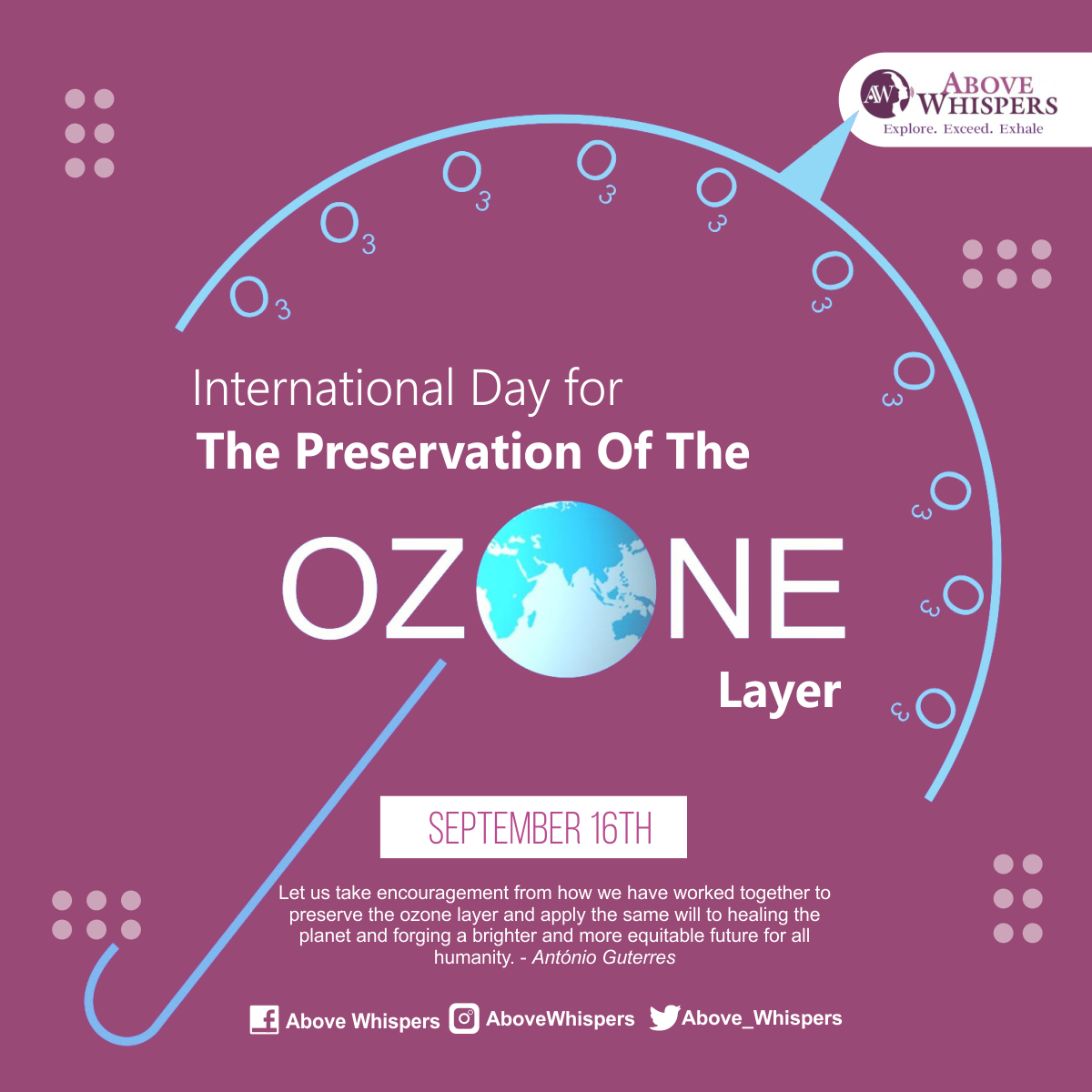What is ozone?
Ozone is a special form of oxygen with the chemical formula O3. The oxygen we breathe and that is so vital to life on earth is O2. Ozone constitutes a very small part of our atmosphere, but its presence is nevertheless vital to human well-being. Most ozone resides high up in the atmosphere, between 10 and 40km above the Earth’s surface. This region is called the stratosphere and it contains about 90% of all the ozone in the atmosphere.

Why do we care about atmospheric ozone?
Ozone in the stratosphere absorbs some of the Sun’s biologically harmful ultraviolet radiation. Because of this beneficial role, stratospheric ozone is considered “good” ozone. In contrast, excess ozone at Earth’s surface that is formed from pollutants is considered “bad” ozone because it can be harmful to humans, plants, and animals. The ozone that occurs naturally near the surface and in the lower atmosphere is also beneficial because ozone helps remove pollutants from the atmosphere.
The hole in the ozone layer
Following the publication of the findings of a British Antarctic Survey article in May 1985, the phenomenon of ozone depletion over Antarctica was referred to as the “ozone hole”, a phrase first attributed to Nobel Prize winner Sherwood Rowland. The satellite image of the ozone hole has become a global symbol of this environmental threat that has helped mobilize public support for the Montreal Protocol. The work of atmospheric scientists and environmental researchers continues to play a paramount role in informing the policymaking under the Montreal Protocol. Images and scientific bulletins about ozone depletion are useful communication tools to the public about progress made and challenges ahead.
Latest ozone measurements
- Global ozone map
Meteorological Service of Canada & Environment Canada - Status of the ozone layer over the South Pole
NASA Ozone Watch
Some Ozone Depleting Substances in Different Industry Sectors
Aerosols, Sterilants and Carbon Tetrachloride
CFCs are used in aerosol products, as sterilants of medical equipment, and in a range of miscellaneous applications including food freezing, tobacco expansion, fumigation and cancer therapy. Carbon tetrachloride is used as a feedstock in the production of CFC-11 and CFC-12, in the production of key pharmaceuticals and agricultural chemicals, and as a catalyst promoter. CFCs and carbon tetrachloride are ozone-depleting substances whose production and consumption is controlled under the Montreal Protocol. With support from the Protocol’s Multilateral Fund delivered by UNEP, UNDP, UNIDO, the World Bank and bilateral agencies, developing countries are phasing out these ozone depleting chemicals in this sector.
Foams
CFCs have been used extensively in the manufacture of polyurethane, phenolic, polystyrene and polyolefin foam polymers, used in many different products. Common blowing agents have included CFC-11, CFC-12, CFC-113 and CFC-114. CFCs are ozone-depleting substances whose production and consumption is controlled under the Montreal Protocol. With support from the Protocol’s Multilateral Fund delivered by UNEP, UNDP, UNIDO, the World Bank and bilateral agencies, developing countries are phasing out these ozone-depleting chemicals in this sector.
Halons
Halon 1211 has been widely used in portable fire extinguishers. Halon 1301 has seen widespread use in fixed systems throughout the industrial, commercial, marine, defence, and aviation industries. Halon 2402 has primarily been used in the defence, industrial, marine and aviation sector in some countries. Halons are ozone-depleting substances whose production and consumption is controlled under the Montreal Protocol. With support from the Protocol’s Multilateral Fund delivered by UNEP, UNDP, UNIDO, the World Bank and bilateral agencies, developing countries are phasing out these ozone-depleting chemicals in this sector.
The strategy for the halon sector essentially consists of two approaches: replacing halons with alternatives, and halon banking. Alternatives to halons include halocarbon alternatives, inert gases, water mist, fine particulate aerosols and streaming agents. In some cases, fire protection strategies may be re-considered and the need for halons eliminated. Halon banking, which includes recovery, recycling and establishing inventories, is used by companies and countries for managing existing halon supplies to cover remaining critical uses.
HCFCs (hydrochlorofluorocarbons)
HCFCs (hydrochlorofluorocarbons) are widely used in the refrigeration, foam, solvent, aerosol and fire fighting sectors as a transitional substance to substitute CFCs. HCFCs are also used as feedstock (raw material) in the production for other chemical products. HCFCs were introduced in the 1990s as alternative chemicals for CFCs and added to the list of substances controlled by the Montreal Protocol. It was acknowledged at the time that these chemicals, with considerably lower ozone-depleting potentials (ODP), were transitional and their production and consumption were also to be phased out under the Montreal Protocol. Although having considerably lower ozone-depleting potentials than CFCs, many HCFCs have high global warming potentials, of up to 2000 times that of carbon dioxide.
In 2006 global HCFC production was 34,400 ODP tonnes and approximately 75% of global HCFC use is in air-conditioning and refrigeration sectors. The main HCFC used is HCFC-22 or chlorodifluoromethane. At the 20th anniversary meeting of the Montreal Protocol on Substances that Deplete the Ozone layer agreement was reached to adjust the Montreal Protocol’s HCFC phase-out schedule to accelerate the phase-out of production and consumption of HCFCs. This decision will result in a significant reduction in ozone depletion and well as in global warming.
Methyl bromide
Methyl bromide is widely used as a fumigant in agriculture, for pest control in structures and stored commodities, and for quarantine treatments. Fumigation is a technique that allows the gas to reach pests which are in the soil, in durables, in perishables, and in structures and vehicles. This chemical controls a wide range of pests, including pathogens (fungi, bacteria and soilborne viruses), insects, mites, nematodes and rodents. Methyl bromide is an ozone-depleting substance that is controlled under the Montreal Protocol. With support from the Protocol’s Multilateral Fund and the Global Environment Facility, developing countries and countries with economies in transition are reducing and ultimately phasing out their consumption of this chemical.
Use of methyl bromide can be reduced and eliminated by adopting alternatives, which have been identified for more than 90 per cent of applications. These include chemicals, non-chemical measures – – including Integrated Pest Management (IPM) – or a combination of both.
Solvents, Coatings & Adhesives
In the past, CFC-113 use was essential in many industrial applications: in electronic assembly production processes, precision cleaning and general metal degreasing during manufacture, as well as in dry cleaning and other industrial applications. CFC-113 began to be used in the 1970s in metal degreasing and other areas owing to concern over the toxicity of the chlorinated solvents used previously. For many years 1,1,1-trichloroethane was the solvent of choice to replace other more toxic chlorinated solvents for general metal cleaning. Carbon tetrachloride is no longer used as a solvent in most countries because of its toxicity, but it is still used in some parts of the world.
CFC-113, 1,1,1-trichloroethane, CTC, and bromochloromethane are ozone-depleting substances whose production and consumption is controlled under the Montreal Protocol. With support from the Protocol’s Multilateral Fund delivered by UNEP, UNDP, UNIDO, the World Bank and bilateral agencies, developing countries are phasing out these ozone-depleting chemicals in this sector.

